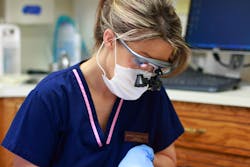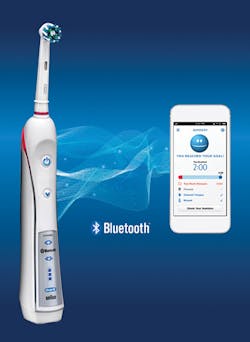Building your best hygiene department
Dr. Graham discusses four factors that will ignite hygiene production and practice growth
Your hygiene team is a key factor in building an effective prevention, treatment, and maintenance program for your patients' oral health. It is also a key factor in building a financially successful practice. It has been estimated that a successful hygiene department generates around 25% to 35% of gross revenue.1
As dentists and practice owners, the economic constraints we face may be discouraging at times. However, there is much we can do to increase revenue. Our hygiene departments should be front and center in this effort. In this article, I will discuss four factors that will ignite hygiene production and practice growth:
• developing goals;
• determining sources of increased revenue;
• making treatment recommendations and improving case acceptance; and
• presenting and prescribing products for oral hygiene and home care.
Developing Goals
Everything starts with your practice's goals. For example, my practice's central goal is to be a health-based practice that helps our patients keep their teeth until their ninetieth birthday (and beyond!). In addition, you must set goals for how our patients should be cared for. Finally, you must set business goals.
As clinicians, we all too often forget we are running a business. In today's challenging economic environment, knowing your practice's financial numbers is essential. For example, in my practice we use Dental Intel to help us track key data. Dental Intel is a web-based practice intelligence platform. It allows me to track key performance indicators (KPIs) on a daily dashboard. As it relates to hygiene, KPIs include same-day hygiene reappointment percentage, hygiene diagnostic percentage, case acceptance percentage, average hygiene production per visit, and new-patient reappointment percentage—just to name a few. Do you know this information for your practice? If not, imagine the power this information provides and what your practice could do with it!
ALSO IN THIS ISSUE:Hygiene Pearls for Your Practice
Determining Sources of Increased Revenue
When you know your KPIs, monthly meetings can be used to create increased revenue from your hygiene team. For example, in our office we have a protocol that fits our practice philosophy and helps drive revenue. Our hygiene team must do the following:
• Wear loupes and lights.
• Be laser certified (we have diodes in every operatory).
• Use Velscope (LED Dental) as part of a 1-2-3 oral cancer screening.
• Perform caries diagnostics using fluorescence (Spectra by Air Techniques) and transillumination (CariVu by DEXIS).
• Take digital x-rays.
This workflow creates huge value for our hygiene team, and it is the backbone of our own University Dental Professionals in-house dental plan. (Yes, things have changed in dentistry and you must be thinking this way!)
Making Treatment Recommendations and Improving Case Acceptance
With our hygiene team, there is great emphasis on patient communication. Dental hygienists are often viewed by patients as friendly and trustworthy sources of information. The patient-hygienist bond is described as a "foundational relationship" in our practice. Patients often want to discuss their concerns or ask about a proposed treatment with their dental hygienists, and this is why the entire team must be working together philosophically and financially.
A treatment acceptance rate of at least 90% is considered a good target, and yet real-world treatment plan acceptance rates are far lower.2 Hygienists should reinforce recommendations and explain how patients benefit. Hygienists can also address patient concerns and allay fears.
Keep this statistic in mind: it is estimated that 75% of restorative needs are initially discovered by the hygiene department.1 The revenue impact of a high-performing hygiene department is therefore critical to a practice's well-being.
Presenting and Prescribing Products for Oral Hygiene and Home Care
Educating patients on home oral care and hygiene products is only as effective as their understanding. It is also a fact that patient compliance with oral hygiene is lower than most of us would like. Oftentimes, patients intend to purchase hygiene products. However, they do not get around to doing so.3
This is not just a trend in dentistry. It is known that many patients don't fill prescriptions required to treat general health conditions (in one study, only 31% of prescriptions were filled over a four-year time period).4 How many times have you seen patients admit that they didn't get around to getting the brush or toothpaste you explained they needed?
As with health-care professionals in other disciplines, we need to know the facts, present and prescribe products as patients need them, and have patients purchase them while in the office.
With hygienists making product presentations and discussing evidence supporting the efficacy of preventatives, it is now easy to educate patients. Each office will have its own thoughts of what products to present. Our practice is 85% adult patients, and product suggestions often begin with the first appointment and evolve during a patient's life.
The role of product recommendations often falls on dental hygienists. Hygienists are on the forefront of ongoing prevention and oral care, and their knowledge of oral disease leads to recommendations based on changes in plaque, salivary flow, caries, and periodontal properties.
One unique product in our office that everyone is trained in (assistants included) is the Oral-B Power Brush and its corresponding Test Drive Program. The program is designed to help patients switch to a power toothbrush. Most patients do not know the proper way to brush, and the Test Drive Program offers our team an opportunity on multiple fronts to promote better oral health.
The Oral-B Test Drive Program is especially beneficial for our geriatric patients. We assemble brushes before they leave the office, and either the assistant or hygienist teaches them (and often their caregiver or family relative, too). We use our phones to video patients and this makes it fun! For our office, the Oral-B Test Drive Program has become a valuable educational tool that has led to far greater power brush usage by our patients.
With strong support and commitment, your dental hygiene department will help you generate revenue and grow your practice. Most importantly, making your hygiene appointments the best they can be will result in greater patient satisfaction, better compliance, better oral hygiene, and improvements in oral health.
Sidebar: Driving Results with Test Drive
The Test Drive Program from Crest Oral-B helps dental hygienists show patients how easy and effective it is to use a power brush. Power brushes have been shown to make a big difference in patients' oral health.
This program allows hygienists to demonstrate the Oral-B oscillating-rotating power brush while patients are still seated in the chair. It presents an opportunity to reinforce oral hygiene and supervise patients to make sure they use the brush properly. Patients are also more likely to purchase one and use it after experiencing the benefits first hand.
References
1. Glasscoe Watterson D. The successful hygiene department: Understanding the numbers. Dental Economics website. http://www.dentaleconomics.com/articles/print/volume-105/issue-7/practice/the-successful-hygiene-department-understanding-the-numbers.html. Published July 15, 2015. Accessed July 7, 2016.
2. Levin RP. Dental practice turnarounds begin with a business analysis. DentistryIQ website. http://www.dentistryiq.com/articles/2014/02/dental-practice-turnarounds-begin-with-a-business-analysis.html. Published February 2014. Accessed July 7, 2016.
3. Beals D, Ngo T, Feng Y, Cook D, Grau DG, Weber DA. Development and laboratory evaluation of a new toothbrush with a novel brush head design. Am J Dent. 2000;13(3):5A-14A.
4. Bakalar N. Many drug prescriptions go unfilled. New York Times website. http://well.blogs.nytimes.com/2014/04/07/many-drug-prescriptions-go-unfilled/?_r=0. Published April 7, 2014. Accessed July 7, 2016.
LOU GRAHAM, DDS, is an internationally recognized lecturer who is involved in continuing education for dental professionals, and he is the founder of the Catapult Group. He focuses on incorporating current clinical advancements through conservative dentistry. He is a graduate of Emory Dental School and is the former dental director of the University of Chicago's Department of Dentistry. He practices in Chicago's Hyde Park area.


